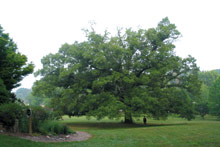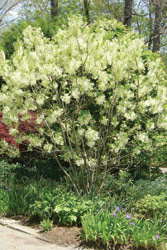With their deeply furrowed bark, sturdy trunks and wide-spreading branches, ancient trees are more revered today than ever.
But be careful when choosing a tree for your yard. Trees are like parrots: They’ll entertain or aggravate you for a lifetime. And in all probability, they’ll outlive you, so take the time to choose well. It’s the surest way to avoid the self-loathing that comes with having to chop down or severely prune a poorly chosen specimen tree.

For gardeners with small lots, the reverence for ancient canopy trees is generally more than offset by a good deal of frustration. Growing other plants beneath these behemoths requires copious amounts of fertilizer, water and compost and still typically yields poor results. Yet even though lot sizes across the U.S. are shrinking, homeowners continue to favor trees that reach gigantic proportions. At Hillside Wholesale Nursery in Etowah, the best sellers by far are the red and sugar maples—particularly those cultivars offering excellent fall color, such as ‘October Glory’, ‘Red Sunset’ and ‘Legacy’. But just one of these surface-rooting, water-sucking monsters will dominate the entire front yard of a quarter-acre lot.
Fortunately, understory trees can be every bit as venerable—and they don’t hog the whole yard. Nothing is more awe-inspiring than a 100-year-old Kousa dogwood or Japanese maple. In fact, one could argue that understory trees are even more beautiful than canopy trees, because they typically have showier blooms and, with age, they develop spectacular bark. Besides, “small” is a relative term. Michael Davey, our region’s only certified master arborist, had to rope his way up a Japanese maple in Biltmore Village recently in order to prune it. The tree’s canopy tops out well above the second-story roofs of Yarn Paradise and Curtis Wright Outfitters on All Souls Crescent.
The best-mannered understory trees won’t gobble up your septic lines or weasel their way into your foundation. Yet many will grow big enough to shade the roof and cool the house, and all will provide a shady place for lawn chairs.
Here’s a list of reliable growers. They won’t be found on every corner, yet they rival or surpass the more common beauties, and they’re guaranteed to impress even the most jaded visitor: fringe tree (Chionanthus virginicus), snowbell (Styrax spp.), hawthorne ‘Winter King’ (Crataegus viridis), stewartia (Stewartia spp.), red buckeye (Aesculus pavia), yellowwood (Cladrastis lutea), and serviceberry (Amelanchier spp.). All of them can grow in our region—zone 7 in Asheville, zone 6 at higher elevations)—and will top out at somewhere between 20 and 30 feet. Their needs vary, so read up their requirements for things like shade vs. sun, good drainage and amended soil.

More familiar small trees such as dogwood, redbud, crape myrtle, crab apple and cherry are equally reliable and beautiful, but since everybody’s already growing these, why not try something different?
Two native trees that fall on the “gorgeous but temperamental” list are the pagoda dogwood (Cornus alternifolia) and Carolina silverbell (Halesia carolina). With light shade, acid soil, decent drainage, and regular water, they are stunning. Another is the Franklinia tree (Franklinia alatamaha). Although many tree books describe it as a nice small tree, it has a bad habit of dying. But it often re-sprouts from the base, and with patience and the right location, you just might win the prize: a very rare and beautiful tree that was once thought to be extinct.
American mountain ash (Sorbus americana) does well at higher elevations in the Southern Appalachians, but good luck: It’s not even worth trying below 4,500 feet. I’m growing its cousin, the Korean mountain ash, beneath a giant old elm that is nearing 100 years old. Vinca, invasive honeysuckle and horrible princess-tree sprouts are the only plants thriving underneath it. In the four years it’s lived in this space, the Korean mountain ash has grown a paltry 6 inches. But despite serious neglect by yours truly, it’s never died back or withered during drought, nor was it affected by last Easter’s unprecedented freeze. If it can survive these conditions under a greedy old elm, it shows great promise as a star of the garden.
Late fall and winter are the best times to plant trees, ideally after the leaves have fallen. Over the winter the semidormant tree can slowly root in, freed from the additional stresses of photosynthesis and transpiration. In the earliest days of spring, the roots expand and by the heat of summer, the tree is sufficiently rooted to take up the water required for growth. But now is the time to go look at trees, while they are in leaf.
Also not to be missed is the Bullington Center (www.bullingtoncenter.org) in Hendersonville. Venerable understory trees planted by the original owner grow near the brick ranch house that now serves as the horticultural-education center. The sculptural qualities of these trees defy description. Pace out their generous dimensions, and file the information in your memory for use when siting that innocent-looking little sapling fresh from the nursery this winter. The rewards will be great.
[Amy Fahmy is horticulturist for Biltmore Farms.]



Before you comment
The comments section is here to provide a platform for civil dialogue on the issues we face together as a local community. Xpress is committed to offering this platform for all voices, but when the tone of the discussion gets nasty or strays off topic, we believe many people choose not to participate. Xpress editors are determined to moderate comments to ensure a constructive interchange is maintained. All comments judged not to be in keeping with the spirit of civil discourse will be removed and repeat violators will be banned. See here for our terms of service. Thank you for being part of this effort to promote respectful discussion.